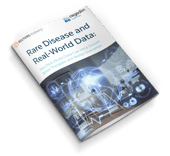5 ways to make optimal use of RWD in rare diseases

Rare disease come with some specific considerations that affect the optimal use of Real-World Data (RWD), including factors that arise due to limited patients and limited data.
Careful planning and definition of the research question
When conducting a study using RWD for a rare disease it can be particularly tempting to ask what data is available and use this to shape the research question, to avoid going back to the drawing board if it turns out there’s not enough data to provide an answer. However, as with any research, it is still important to identify the research question in advance and seek the appropriate data sources afterwards. This also helps the researcher define priorities and avoid being distracted by the large volume and variety of RWD available, which can quickly lead things astray without a thorough analysis plan.
Early engagement with patients
Engaging with patients and understanding what matters most to them early on in a clinical development plan can help define the study questions and outcomes that are of value to patients. If engaged early, patients can help create patient reported outcomes (PROs) to measure against, an important part of establishing the value of a new investigational therapy, according to Jacki Lyons. Whereas if patients are only consulted when a potential treatment is approaching submission, it could be too late to understand the most important unmet medical needs from the patient point of view.
She also argues that listening to patients and understanding their needs can help researchers build trust so that they are more likely to want to contribute their data towards advancing a new treatment that could help them or others like them in the future.
That said, the question of involving patients is not simply about “when” to engage them in terms of the clinical development plan. It is also astute to ask “when and where” to engage them in their individual healthcare journeys. In terms of treating rare diseases, identifying the patient pathway is very important to improve detection early on at primary care levels, to help the physician to detect symptoms and refer patients to a specialist.

Rare Diseases Whitepaper
Rare Disease and Real-World Data: How Real-World Data Can Help Deliver Better Therapies and Better Outcomes
Use of technology to alleviate clinician burden
Software and platforms used to capture and analyse RWD have accelerated considerably in recent years, with COVID-19 acting as a catalyst in many ways. Technology can be used to not only enhance research, but it can also be used to enhance patient care at a clinical level.
In the clinic, healthcare professionals can provide better care to patients with advanced analytics and AI, flagging areas of interest for the HCP to investigate further, such as potential risks, unforeseen diagnoses, and treatment pathways according to the data.
Physician motivation to enrol and use data capture systems is vitally important for researchers. It should not be underestimated that technology which helps healthcare professionals save time, rather than adding to their burden of work, is crucially important.
This lesson is all too clear given the staff shortages following the “Great Resignation” facing healthcare systems globally, including Europe, due to burnout during and after the pandemic. In Italy 2.9% of doctors resigned in 2019 and in the two-year period from 2020 to 2021 18% of students in Italian emergency medicine abandoned their studies, whilst in France, France24 reported that 20% of beds in public hospitals had closed in 2021 due to a lack of caregivers, and 1,300 nursing students resigned between 2018 and 2021.
Decision-making that “wraps around” technology
According to Prof. Pierre-Antoine Gourraud, technology is not the central issue when it comes to data warehouses for RWD, including those for rare diseases.
Data governance - how the data is plugged into the database is now the central issue, particularly when it comes to long-term interoperability of the data.
“I have one full-time person that is really dedicated to entering the data into the database. They’re actually much more expensive than the software, and they are way more important, because they always make decisions about what type of data we are storing, so they need to be skilled and well trained to maintain the data quality.”
Choosing the right real-world data partner
Data partners under various pressures, including intellectual property, commercial secrecy, or time pressures, need to maintain full transparency with different stakeholders such as healthcare authorities, the pharmaceutical industry and others when providing RWD or RWE enabling sponsors to uphold their obligations to regulators during the review process.
Sometimes different stakeholders (such as clinicians and epidemiologists, for example) will look at the same data at the same time and want to discuss entirely different points. That’s why the source and the reason for delivering the data needs to be clear and a discussion between clinicians, epidemiologists, regulators and pharma needs to be open and informed.
“It’s always a fantastic discussion,” says Gilles Paubert, “when you are trying to discuss RWE with a clinician and an epidemiologist both of whom are doctors, but they’re not speaking the same language. So, it’s very important that in the middle, we are providing an auditor and really expanding on where the data has been created, for what purpose, and how.”



